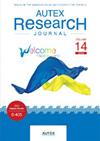Use of enzymatic processes in the tanning of leather materials
IF 1.6
4区 工程技术
Q3 MATERIALS SCIENCE, TEXTILES
引用次数: 0
Abstract
The policy of sustainable development, the need to save natural environmental resources, and the use of waste as raw materials in new production processes allow the use of enzymes in many industries. Enzymatic tanning and chrome tanning are two different methods used in the leather industry to transform raw hides into a durable and usable material. Enzymatic tanning uses natural enzymes that are biodegradable and environmentally friendly. Additionally, enzymatic tanning requires less water and generates less waste than chrome tanning. Moreover, enzymatic tanning can result in softer and more flexible leather with better uniformity. Enzymes selectively break down collagen fibers, resulting in a more even tanning and a consistent leather product. The use of combined enzymatic technologies with non-obvious leather finishing methodologies in tanning is forced by European Union regulations limiting the use of hazardous substances and generating significant amounts of corrosive wastewater for the environment. However, tanning with enzymes is not a perfect process; therefore, this work presents the advantages and disadvantages of tanning with enzymes and describes new technological trends in the tanning industry.在皮革材料的鞣制过程中使用酶法工艺
可持续发展政策、节约自然环境资源的需要以及在新的生产工艺中使用废物作为原材料,使得酶在许多行业中得到应用。酶法鞣革和铬法鞣革是皮革业将生皮转化为耐用可用材料的两种不同方法。酶法鞣革使用的是可生物降解且环保的天然酶。此外,与铬鞣相比,酶鞣需要的水更少,产生的废物也更少。此外,酶法鞣制的皮革更柔软、更有弹性,均匀度更高。酶选择性地分解胶原纤维,使鞣制更加均匀,皮革产品更加一致。由于欧盟法规限制使用有害物质和产生大量对环境有腐蚀性的废水,因此在鞣制过程中不得不将酶技术与非显而易见的皮革涂饰方法结合使用。然而,使用酶进行鞣制并不是一个完美的过程;因此,这项工作介绍了使用酶进行鞣制的优缺点,并描述了鞣制行业的新技术趋势。
本文章由计算机程序翻译,如有差异,请以英文原文为准。
求助全文
约1分钟内获得全文
求助全文
来源期刊

Autex Research Journal
MATERIALS SCIENCE, TEXTILES-
CiteScore
2.80
自引率
9.10%
发文量
40
审稿时长
>12 weeks
期刊介绍:
Only few journals deal with textile research at an international and global level complying with the highest standards.
Autex Research Journal has the aim to play a leading role in distributing scientific and technological research results on textiles publishing original and innovative papers after peer reviewing, guaranteeing quality and excellence.
Everybody dedicated to textiles and textile related materials is invited to submit papers and to contribute to a positive and appealing image of this Journal.
 求助内容:
求助内容: 应助结果提醒方式:
应助结果提醒方式:


